|
|
|
Sort Order |
|
|
|
Items / Page
|
|
|
|
|
|
|
| Srl | Item |
| 1 |
ID:
148787
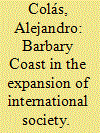

|
|
|
|
|
| Summary/Abstract |
From the ‘long’ sixteenth century the Ottoman regencies of North Africa operated as major centres of piracy and privateering across the Mediterranean Sea. Though deemed by emerging European powers to be an expression of the ‘barbarian’ status of Muslim and Ottoman rulers and peoples, piracy, and corsairing in fact played a major role in the development of the ‘primary’ or ‘master’ institutions of international society such as sovereignty, war, or international law. Far from representing a ‘barbarian’ challenge to the European ‘standard of civilization’, piracy and privateering in the modern Mediterranean acted as contradictory vehicles in the affirmation of that very standard.
|
|
|
|
|
|
|
|
|
|
|
|
|
|
|
|
| 2 |
ID:
138069
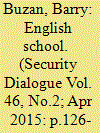

|
|
|
|
|
| Summary/Abstract |
The terms ‘English School’ (ES) and ‘international security’ seldom appear in the same sentence. Yet the ES can and should constitute a general approach to International Security Studies (ISS) comparable to realism, liberalism, constructivism and several other approaches to International relations (IR). The article begins by sketching out how the ES’s idea of raison de système provides a general framing for ISS that counterpoints approaches focused on raison d’état. It then shows how the ES’s societal approach provides specific insights that could strengthen analysis of international security: by providing a normative framing for securitization; by showing the historical variability of key ISS concepts such as war, balance of power and human rights; by adding an inside/outside dimension to security relations based on differentiations within international society; and by complementing regional approaches to international security with its societal approach. The article aims to initiate a conversation between the ES and ISS by showing where the fruitful links are, and by introducing the relevant ES literature to ISS scholars.
|
|
|
|
|
|
|
|
|
|
|
|
|
|
|
|
| 3 |
ID:
171921


|
|
|
|
|
| Summary/Abstract |
Refugees are often considered as a source of disorder if not fundamental threat to international society. In contrast, and drawing from an English School approach, this article argues that the figure of the refugee is foundational to the constitution of both modern international society and its agent, the sovereign territorial state; hence refugee protection represents a primary institution of international society. Starting with conceptual and methodological considerations for studying primary institutions, the article then highlights the longstanding and widespread state practice of granting asylum. It is shown that on the one hand, the figure of the refugee serves to consolidate and naturalise the nation/state/territory trinity underpinning the modern state system; and on the other hand, protecting refugees plays a central role in the construction of statist self-identities as liberal, humanitarian, and altruistic agents. The last section of the article turns to the politics of contestation of refugee protection, examining domestic, regional, and international reactions to ‘anti-refugee’ policies in the United States, Hungary, and Australia. The considerable amount of criticism generated by these restrictive policies, it is argued, evidence the enduring importance and relevance of refugee protection in (and for) international society.
|
|
|
|
|
|
|
|
|
|
|
|
|
|
|
|
| 4 |
ID:
104035
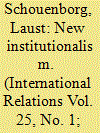

|
|
|
|
|
| Publication |
2011.
|
| Summary/Abstract |
In this article I engage with the theoretical opening provided by Barry Buzan's From International to World Society? I present an argument for five functional categories, which should be able to encompass all the institutions identified by English School scholars throughout history. Their introduction should point the way towards a sounder analytical framework for the study of what Buzan believes should be the new subject of the discipline of International Relations (IR). This subject is defined as second-order societies, meaning societies 'where the members are not individual human beings, but durable collectivities of humans possessed of identities and actor qualities that are more than the sum of their parts', and where the content of these societies, and the key object of analysis, is primary institutions. The purpose of the five functional categories is to break down this 'social whole' and provide a set of lenses through which to potentially analyse international societies throughout history.
|
|
|
|
|
|
|
|
|
|
|
|
|
|
|
|
| 5 |
ID:
178694
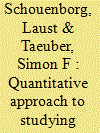

|
|
|
|
|
| Summary/Abstract |
In this article, we aim to contribute to two contemporary debates within the English School. The debate about how to observe primary institutions and the debate concerning hierarchy between primary institutions. Specifically, we analyse references to primary institutions in United Nations General Assembly disarmament resolutions in the decade 1989–1998 and their distribution using descriptive statistics. In this way, the article offers a novel approach to identifying primary institutions empirically, and provides some insight into the hierarchy-question in the sense of documenting the relative numerical presence of references to different primary institutions in a specific issue area and temporal context. With respect to the latter, the key finding is that great power management, diplomacy and international law are by far the most prominent primary institutions in the analysed material. This is an intriguing finding, not least given the importance attached to them by Hedley Bull in his classic work The Anarchical Society: A Study of Order in World Politics. The main contribution of the article is thus to spell out a new approach to how the aforementioned debates might proceed empirically.
|
|
|
|
|
|
|
|
|
|
|
|
|
|
|
|
| 6 |
ID:
189872
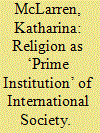

|
|
|
|
|
| Summary/Abstract |
Religion features in early English School work, disappears, and reappears in more recent literature. Arguably, it has not yet found a solid place in this theoretical framework, even though the English School is known to provide angles on the evolution of international society other approaches lack. Religion can unite and divide; leading to a strengthening or a weakening of identity and legitimacy. Faith endures and it can exist independently of states, it can constitute them and it can provide new forms of states and societies. Employing previous English School ideas from early and contemporary English School scholars as points of departure, religion is introduced as a ‘prime institution’. Based on the English School’s understanding of primary institutions constituting international society, this concept of a ‘prime institution’ provides an additional layer to international society. Such a prime institution helps grasp the multifacetedness of religion in the context of international society; identify patterns of religion’s (in-) significance for primary institutions; and examine the difference between religious and religion-averse states within the international society. This prime institution is illustrated with a so-called ‘quilt model’, which depicts the multiple layers of international society.
|
|
|
|
|
|
|
|
|
|
|
|
|
|
|
|
|
|
|
|
|